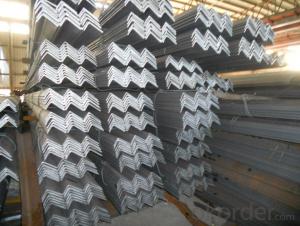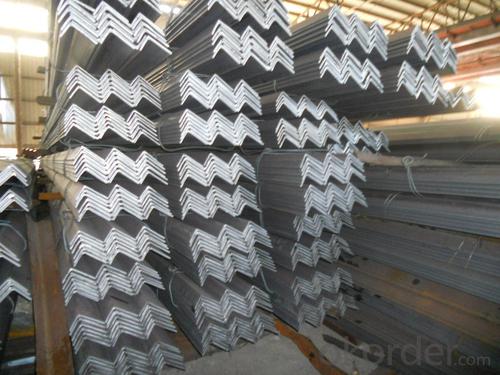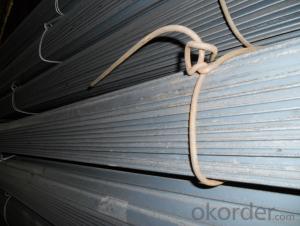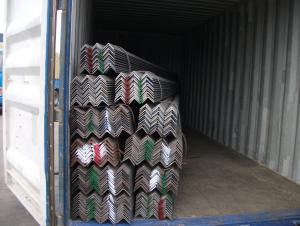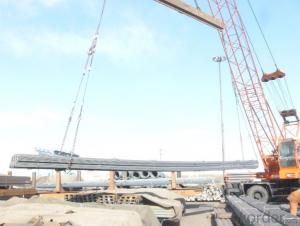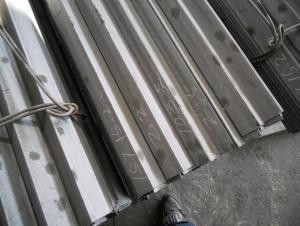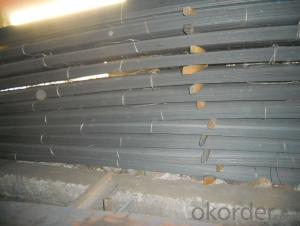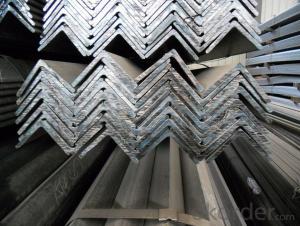High Quality Hot Rolled Carbon Steel Equal Angle
- Loading Port:
- Tianjin
- Payment Terms:
- TT or LC
- Min Order Qty:
- 20 m.t.
- Supply Capability:
- 1000 m.t./month
OKorder Service Pledge
OKorder Financial Service
You Might Also Like
Product Description:
OKorder is offering Hot Rolled Carbon Steel Equal Angle at great prices with worldwide shipping. Our supplier is a world-class manufacturer of steel, with our products utilized the world over. OKorder annually supplies products to European, North American and Asian markets. We provide quotations within 24 hours of receiving an inquiry and guarantee competitive prices.
Product Applications:
According to the needs of different structures, Angle can compose to different force support component, and also can be the connections between components. It is widely used in various building structures and engineering structures such as roof beams, bridges, transmission towers, hoisting machinery and transport machinery, ships, industrial furnaces, reaction tower, container frame and warehouse etc.
Product Advantages:
OKorder's Equal Angle are durable, strong, and resist corrosion.
Main Product Features:
· Premium quality
· Prompt delivery & seaworthy packing (30 days after receiving deposit)
· Corrosion resistance
· Can be recycled and reused
· Mill test certification
· Professional Service
· Competitive pricing
Product Specifications:
1. Invoicing on theoretical weight or actual weight as customer request
2. Length: 6m, 9m, 12m as following table
3. Sizes

Sizes: 25mm-250mm | ||
a*t | ||
25*2.5-4.0 | 70*6.0-9.0 | 130*9.0-15 |
30*2.5-6.6 | 75*6.0-9.0 | 140*10-14 |
36*3.0-5.0 | 80*5.0-10 | 150*10-20 |
38*2.3-6.0 | 90*7.0-10 | 160*10-16 |
40*3.0-5.0 | 100*6.0-12 | 175*12-15 |
45*4.0-6.0 | 110*8.0-10 | 180*12-18 |
50*4.0-6.0 | 120*6.0-15 | 200*14-25 |
60*4.0-8.0 | 125*8.0-14 | 250*25 |
4.Material details:
Alloy No | Grade | Element (%) | |||||
C | Mn | S | P | Si | |||
Q235 | B | 0.12—0.20 | 0.3—0.7 | ≤0.045 | ≤0.045 | ≤0.3 | |
Alloy No | Grade | Yielding strength point( Mpa) | |||||
Thickness (mm) | |||||||
≤16 | >16--40 | >40--60 | >60--100 | ||||
≥ | |||||||
Q235 | B | 235 | 225 | 215 | 205 | ||
Alloy No | Grade | Tensile strength (Mpa) | Elongation after fracture (%) | ||||
Thickness (mm) | |||||||
≤16 | >16--40 | >40--60 | >60--100 | ||||
≥ | |||||||
Q235 | B | 375--500 | 26 | 25 | 24 | 23 | |
FAQ:
Q1: Why buy Materials & Equipment from OKorder.com?
A1: All products offered byOKorder.com are carefully selected from China's most reliable manufacturing enterprises. Through its ISO certifications, OKorder.com adheres to the highest standards and a commitment to supply chain safety and customer satisfaction.
Q2: How do we guarantee the quality of our products?
A2: We have established an advanced quality management system which conducts strict quality tests at every step, from raw materials to the final product. At the same time, we provide extensive follow-up service assurances as required.
Q3: How soon can we receive the product after purchase?
A3: Within three days of placing an order, we will begin production. The specific shipping date is dependent upon international and government factors, but is typically 7 to 10 workdays.
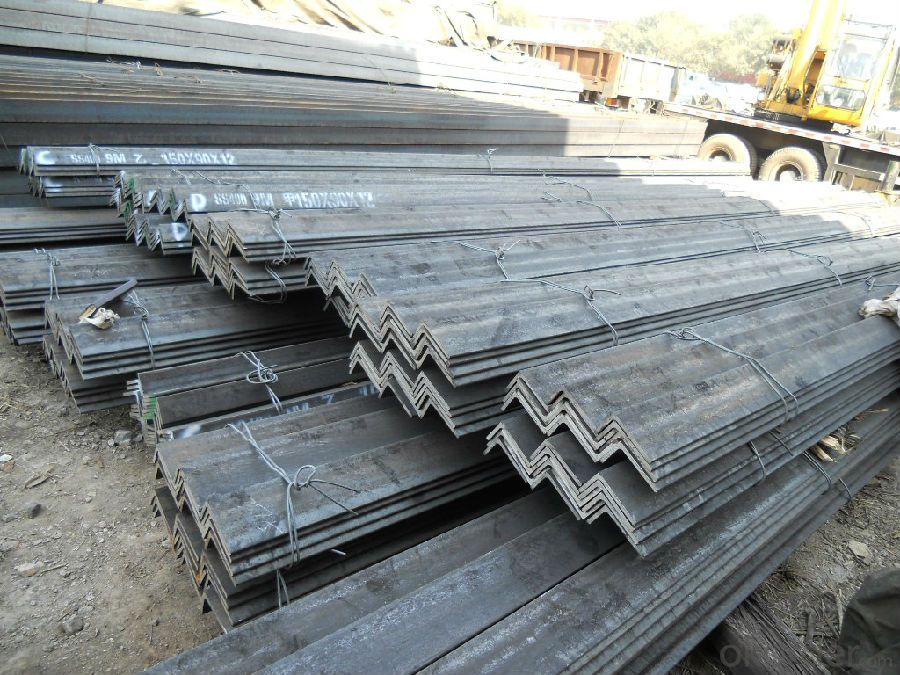
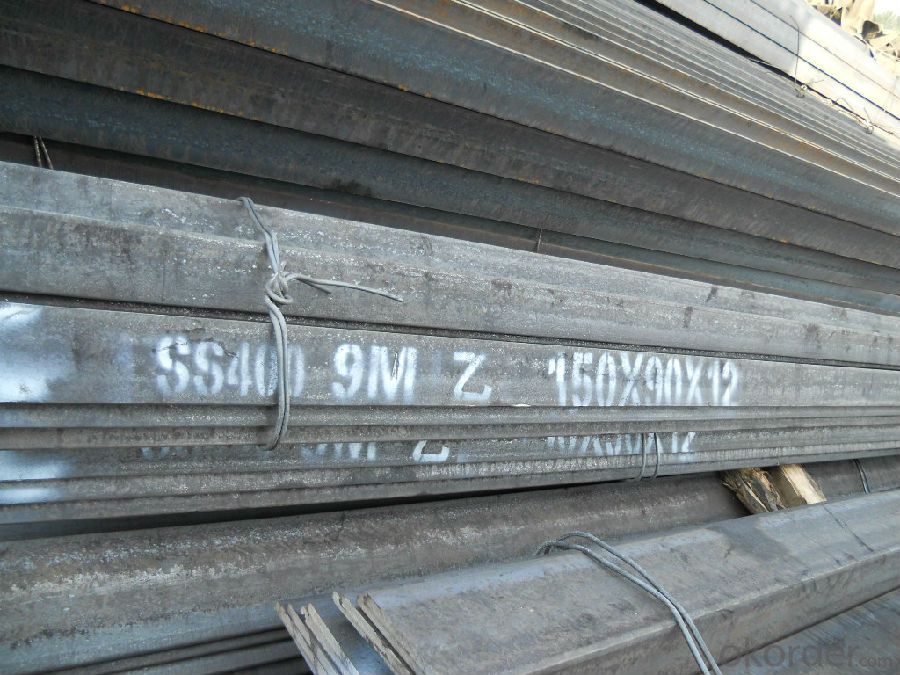
- Q: How do you prevent warping of steel angles during fabrication?
- To prevent warping of steel angles during fabrication, several measures can be taken. Firstly, it is essential to ensure proper storage and handling of the angles to avoid any bending or twisting. During welding or heating processes, it is crucial to control the temperature and heat distribution evenly to prevent localized expansion or contraction that may lead to warping. Additionally, using proper clamping or fixturing techniques can help maintain the desired shape and prevent warping. Lastly, post-fabrication processes like stress relieving or annealing can be employed to release any residual stresses in the angles and minimize the risk of warping.
- Q: What are the different corrosion protection methods for steel angles?
- There are several different corrosion protection methods available for steel angles, depending on the specific application and environmental conditions. Some of the most common methods include: 1. Galvanization: This involves coating the steel angles with a layer of zinc, which provides excellent corrosion resistance. The zinc layer acts as a sacrificial anode, corroding instead of the underlying steel. 2. Paint coatings: Applying a high-quality paint coating to the steel angles can provide effective corrosion protection. The paint acts as a barrier, preventing moisture and corrosive substances from reaching the steel surface. 3. Powder coating: Similar to paint coatings, powder coating involves applying a dry powder to the steel angles and then baking it to create a durable and corrosion-resistant finish. 4. Epoxy coatings: Epoxy coatings are commonly used for steel angles that will be exposed to harsh environments or aggressive chemicals. These coatings provide excellent adhesion and resistance to corrosion. 5. Cathodic protection: This method involves using a sacrificial anode or impressed current to protect the steel angles from corrosion. The anode corrodes instead of the steel, providing long-term protection. 6. Barrier coatings: Barrier coatings, such as polyethylene or PVC wraps, provide a physical barrier between the steel angles and the surrounding environment, preventing moisture and corrosive substances from reaching the surface. 7. Hot-dip galvanizing: In this method, the steel angles are immersed in a bath of molten zinc, creating a thick layer of zinc coating that offers excellent corrosion protection. It is important to consider the specific requirements of the application when choosing a corrosion protection method for steel angles. Factors such as the environment, expected service life, and budget should be taken into account to ensure the most suitable protection method is selected.
- Q: Can steel angles be used for manufacturing playground equipment?
- Yes, steel angles can be used for manufacturing playground equipment. Steel angles are commonly used in construction and manufacturing due to their strength and durability. They can be used to create the framework and support structures for various types of playground equipment, such as slides, climbing frames, and swing sets. The versatility of steel angles allows for the creation of safe and sturdy playground equipment that can withstand heavy use and harsh weather conditions. Additionally, steel angles can be easily welded, cut, and shaped to suit specific design requirements, making them an ideal choice for playground equipment manufacturers.
- Q: Can steel angles be painted or coated after installation?
- Yes, steel angles can be painted or coated after installation. Painting or coating steel angles after installation can provide additional protection against corrosion and enhance their aesthetic appeal. Prior to painting or coating, it is important to clean and prepare the surface by removing any dirt, rust, or contaminants. This can be done through techniques such as sandblasting, wire brushing, or using chemical cleaners. Once the surface is clean and dry, a suitable primer can be applied to promote adhesion and prevent corrosion. After the primer has dried, a final coat of paint or coating can be applied using a brush, roller, or spray. It is essential to choose a paint or coating that is specifically designed for steel and offers the desired level of protection and durability.
- Q: Can steel angles be used in curtain wall construction?
- Indeed, curtain wall construction can make use of steel angles. In fact, steel angles find frequent application as framing elements in curtain wall systems, offering both structural reinforcement and stability. Typically, they function as mullions or transoms, which are the vertical and horizontal components responsible for securing the glass panels. The preference for steel angles stems from their robustness, endurance, and capacity to withstand the various burdens and pressures associated with the curtain wall system. Moreover, steel angles can be conveniently fabricated and installed, rendering them a highly sought-after option in curtain wall construction.
- Q: What is the maximum deflection for a steel angle beam?
- The maximum deflection for a steel angle beam depends on several factors including the dimensions of the beam, the material properties of the steel, and the applied load. It is calculated using engineering principles and can be determined using formulas and calculations specific to the beam's geometry and loading conditions. Therefore, without specific information about these factors, it is not possible to provide a definitive answer to the maximum deflection of a steel angle beam.
- Q: Can steel angles be used in the construction of pipe racks?
- Indeed, the utilization of steel angles is applicable in the construction of pipe racks. Steel angles play a vital role in furnishing the necessary structural support and stability required for pipe racks, thereby rendering them an ideal choice for this particular type of construction. These angles can be employed to fabricate a framework or framework support system for the pipe rack, thereby ensuring its robustness and ability to withstand the weight and pressure exerted by the pipes. Moreover, steel angles possess remarkable durability and resistance to corrosion, which proves crucial in an environment where pipes may be exposed to a variety of elements. In summary, steel angles are an appropriate and commonly utilized material in the construction of pipe racks.
- Q: What is the typical density of steel angles?
- Steel angles can have varying densities depending on the particular steel type and grade employed. On average, their density falls within the range of 7.7 to 8.1 grams per cubic centimeter (g/cm³), or equivalently 7700 to 8100 kilograms per cubic meter (kg/m³). In comparison to other substances, steel angles possess a notably high density, imparting strength and durability for a multitude of structural and construction purposes.
- Q: What are the common methods of joining steel angles together?
- There are several common methods for joining steel angles together. 1. Welding: Welding is a popular method used to join steel angles together. It involves melting the edges of the angles and then allowing them to cool and solidify, creating a strong bond. Welding can be done using various techniques such as arc welding, MIG welding, or TIG welding. 2. Bolting: Bolting is another common method used to join steel angles. It involves using bolts, nuts, and washers to secure the angles together. This method allows for easy disassembly and reassembly if needed. Bolts are typically used in conjunction with gusset plates or brackets to provide additional strength and stability. 3. Riveting: Riveting is a traditional method of joining steel angles together. It involves using a rivet, which is a cylindrical metal pin, to hold the angles in place. The rivet is inserted into pre-drilled holes in the angles and then deformed on one end to create a head, securing the angles together. 4. Adhesive bonding: Adhesive bonding is a method that involves using a specialized adhesive to join steel angles together. The adhesive is applied between the angles, and then pressure is applied to ensure a strong bond. Adhesive bonding is often used in situations where a clean and aesthetically pleasing joint is desired. 5. Mechanical fasteners: Mechanical fasteners such as screws, nails, or self-tapping screws can also be used to join steel angles together. These fasteners are inserted into pre-drilled holes and provide a secure connection. However, they may not be as strong as other methods such as welding or bolting. It is important to consider the specific requirements of the application, such as the load-bearing capacity, aesthetics, and ease of disassembly, when choosing the appropriate method for joining steel angles together.
- Q: What is the maximum temperature that steel angles can withstand?
- The maximum temperature that steel angles can withstand depends on the specific type and grade of steel being used. However, in general, most steel angles can withstand temperatures up to around 1000 to 1200 degrees Celsius (1832 to 2192 degrees Fahrenheit) before they start to lose their structural integrity and strength.
Send your message to us
High Quality Hot Rolled Carbon Steel Equal Angle
- Loading Port:
- Tianjin
- Payment Terms:
- TT or LC
- Min Order Qty:
- 20 m.t.
- Supply Capability:
- 1000 m.t./month
OKorder Service Pledge
OKorder Financial Service
Similar products
Hot products
Hot Searches
Related keywords
